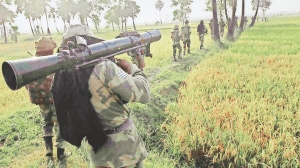Fruits of Activity
Recently,a photograph of seven uneven tiles placed carefully one on top of another,with the biggest at the bottom and the smallest at the top,flashed repeatedly on the Facebook newsfeed.
Recently,a photograph of seven uneven tiles placed carefully one on top of another,with the biggest at the bottom and the smallest at the top,flashed repeatedly on the Facebook newsfeed.
Recently,a photograph of seven uneven tiles placed carefully one on top of another,with the biggest at the bottom and the smallest at the top,flashed repeatedly on the Facebook newsfeed. The caption reads,If you know what this is,you had an awesome childhood! Seven tiles,one ball,enthusiastic participants that is all it took for mayhem and dust-filled evenings of pitthu or lagori.
The game required the strategy of armies and the athleticism of youth as one team attempted to rebuild its citadel of stones and the other tried to stymie their efforts. It involved feats of running,jumping,screaming,aiming,ducking,but it was always undiluted fun.
Play differentiates childhood from adulthood. It is that one activity complete in itself,which can be substituted by none other. It contains its own elaborate web of rules and hierarchies,but ultimately,it serves only one purpose that of enjoyment. As adults,memories of the games we played,the people we played with and the locations we played at,form the foundation of our childhood.
International Play Association (IPA),founded in 1961,aims to promote the childs right to play as a fundamental human right,in accordance with Article 31 of the United Nations Convention on the Rights of the Child.
The freedom to play doesn’t mean only the freedom to fly a kite or swing a ball or roll in the mud. It is also the opportunity to learn coordination,cooperation and to realise that actions have consequences. It is the first method through which a child interacts with the world and understands that the world responds in unpredictable ways. As our cities grow,with brick and mortar replacing trees and mud,the way we play also changes.
Sudeshna Chatterjee,architect,urban designer and partner at Kaimal,Chatterjee and Associates,Delhi,who has worked extensively on how children use their environment,says,We live in a society with many different forms of childhood. In high-rise apartments there is no free play. Cognitive mapping in apartments is difficult and confusing. Children find it much easier in horizontal spaces. The neighbourhood doesn’t play a role in the growing up of children. A pretty park most often has strict rules and is not necessarily a child-friendly space.
The park bordering Delhi’s Jama Masjid,adjacent to Urdu Bazaar,is not a pretty place. The turrets of the mosque form an imposing backdrop but the park itself is a barren landscape,with two dilapidated shelters,a makeshift tent and a series of leaking toilets. Most of the children playing here are rag-pickers or sweepers hailing from Uttar Pradesh. Many,as young as nine or 10,hold rags to their faces and proclaim,Main ek rumaal subeh peeta hu aur ek shaam ko. (I sniff one in the morning and one in the evening) Award-winning photographer Lana Slezic has taken a series of photographs titled Walk in the Park (published in Newsweek) of these children. Slezic’s memories of parks in Canada flutter with bright leaves,dappled sunlight and rocking swings. Here,she finds none of those delights and perks. Believing that street children,poverty and destitution in India have been over-shot,overdone and over-told,she chose to photograph each child individually against a black backdrop. In her portraits,the attention moves away from the context and surroundings,focusing only on the child doing what he/she does best being a child. Photographs of a boy pulling up his pants,posing with a broom or throwing a toffee wrapper in the air capture the child in that one moment of freedom from circumstance and the freedom to be.
Mrinmoyee Majumdar,an art-based therapist,has studied how children use and interpret space at Khirki village in Delhi. She realised that while children don’t ask for much,they can make a chariot or cocoon from a cardboard box,they need a space that doesn’t patronise them and one that doesnt rationalises play. They don’t need the kit,fence carpets of malls,but the rough and tumble of the maidan or the driveway. They need a sandbox which will teach that eating mud will give them an upset stomach and allow them the freedom to make and break castles.



- 01
- 02
- 03
- 04
- 05




























